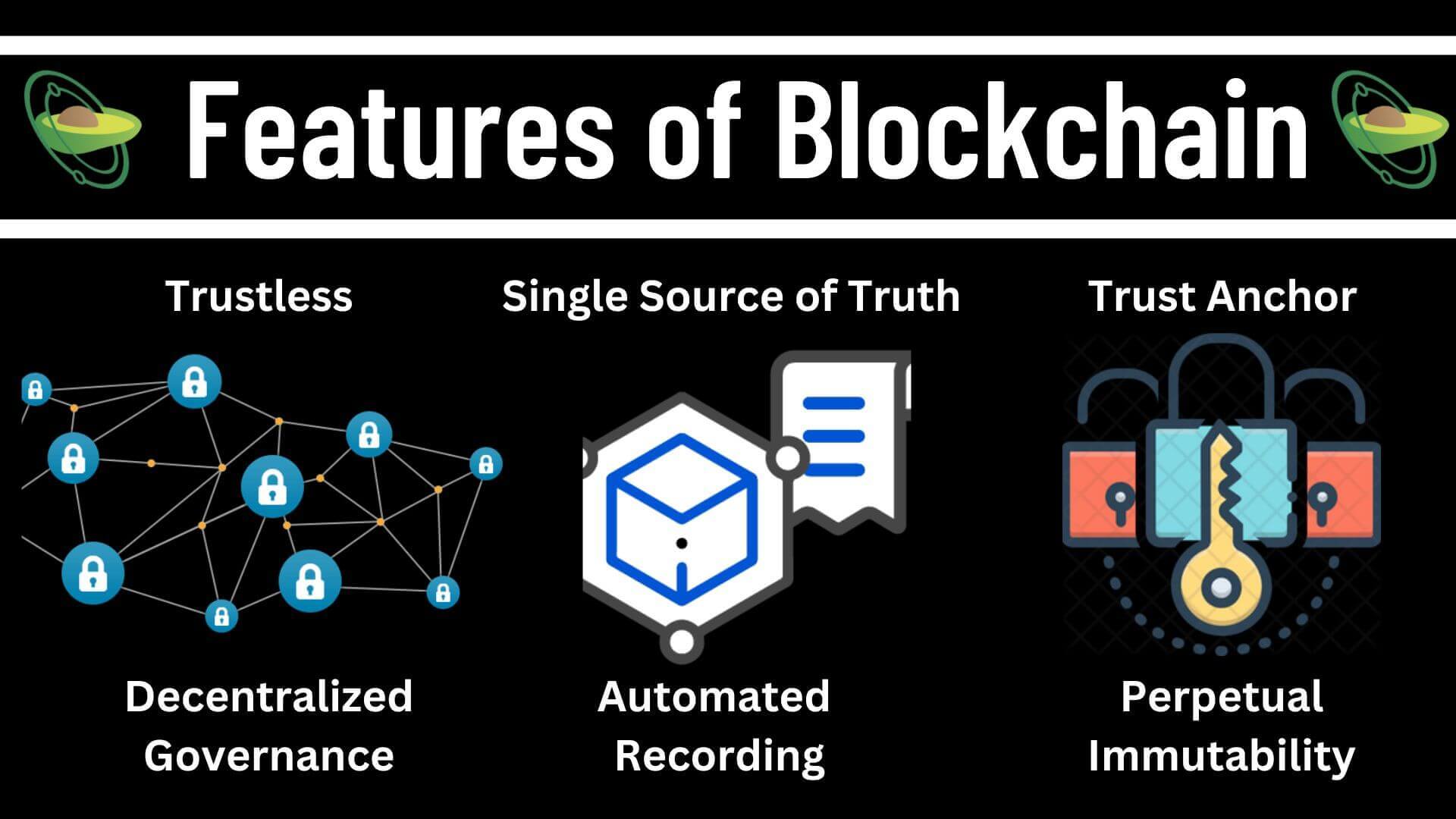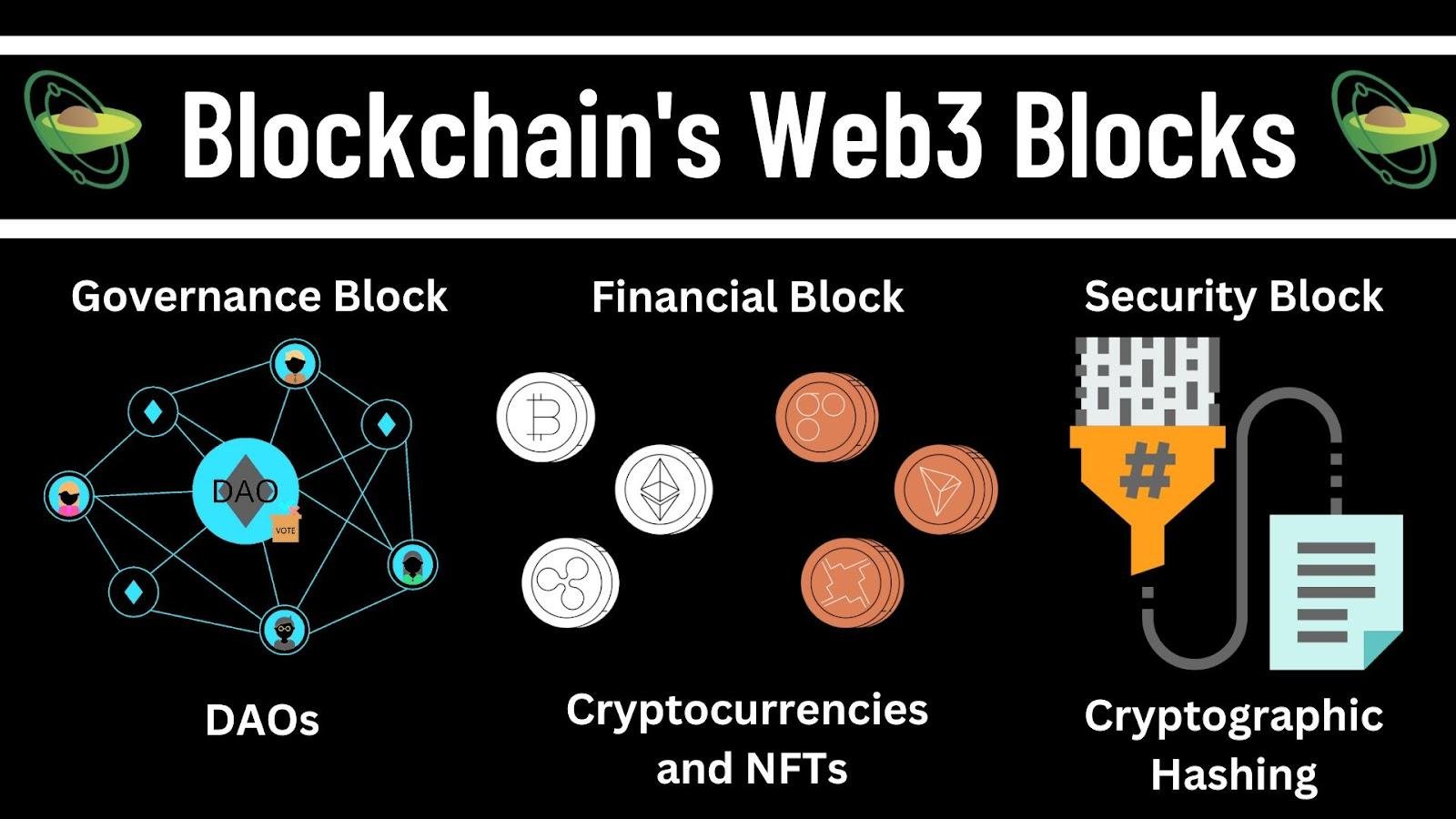
Distributed Ledger Technology (DLT) refers to databases that store ledger records in a decentralized manner. This decentralization feature entails the element of disintermediation by eliminating the need for any intermediary such as banks for the processing and and validating the authentication of transactions. As for blockchain, it is a specific subset of DLT which uses cryptographic hashing.
In essence, data on blockchain networks are stored in blocks and chained together using cryptographic hashes, hence the name blockchain. The relationship between blockchain and DLT is best explained as "all blockchains are DLT but not all DLT are blockchains".
(2) Key Features of BlockchainThanks to its decentralized governance, automated recording, and perpetual immutability features, blockchain has embodied the nature of being trustless as well as functioning as a single source of truth and trust anchor.
 Features of Blockchain (Source: Avocado DAO)
Features of Blockchain (Source: Avocado DAO)
The decentralized governance framework of blockchain renders the technology to be trustless. With its peer-to-peer (P2P) network, blockchain’s operations do not require nodes to know or trust each other. This dispensation of the need to know creates a trustless environment where no single authority controls the system.
(b) Automated RecordingThe automated recording feature of blockchain records renders the technology to be the single source of truth. As every single transaction undertaken on a blockchain network would be automatically recorded, there is no need to refer to other sources of information beyond these records.
(c) Perpetual ImmutabilityThe perpetual immutability nature of blockchain records renders the technology to be a trust anchor. Thanks to the permanent and indelible nature of its records, the data stored in the ledger records of blockchain networks can be taken at face value as the be-all and end-all of the subject matter under consideration.
Through its key features of decentralized governance, automated recording, and perpetual immutability, blockchain is the primary technological enabler that renders Web3 a plausible reality.
(3) Blockchain as the Technological Enabler of Web3In many ways, blockchain and Web3 are inextricably tied to one another, so much so that blockchain has become synonymous with Web3. The synonymous nature of blockchain and Web3 is due to the role of the blockchain in supporting the governance, financial and security blocks of Web3.
 Blockchain’s Web3 Blocks (Source: Avocado DAO)
Blockchain’s Web3 Blocks (Source: Avocado DAO)
The advent of blockchain has given rise to smart contracts. The rise in smart contracts, in turn, has facilitated the establishment of Decentralized Autonomous Organizations (DAOs), a staple of Web3. The role of blockchain-based smart contracts in DAOs is that they facilitate the submission and voting of proposals concerning the governance of these organizations.
In this manner, DAOs are operated and managed by the members of Web3-based communities themselves. An example of a DAO is Avocado DAO, the DAO for Avocado Guild.
(b) Financial BlockThe economic framework of Web3 is supported by cryptocurrencies and non-fungible tokens (NFTs). Concerning cryptocurrencies, they have catalyzed the establishment of the decentralized finance (DeFI) domain which serves as the financial bedrock of Web3. Additionally, cryptocurrencies have also catalyzed the establishment of industry horizontals such as educational finance (EduFi), gamification (GameFi), and social finance (SocialFi) which are enmeshed in the fabric of Web3.
Topping it all off are NFTs which serve as the foundation that supports Web3’s creator economy. The key feature of NFT is that its value is determined primarily by the community. In addition to the background and portfolio of the creator, some other factors on which the value of an NFT is based includes its originality, rarity and utility.
(c) Security BlockThanks to cryptographic hashing (which refers to the use of cryptographic functions to convert inputs in the form of letters and numbers into encrypted outputs), blockchain networks are mathematically impossible and impractical to hack. Accordingly, using blockchain networks provides a high degree of security protection for Web3 as these networks are immune to data tampering and double-spending as well as Denial of Service (DoS) and Man-in-the-Middle (MITM) attacks. Nonetheless, blockchain networks are not foolproof as they are not entirely immune to security risks, with the vulnerability stemming from both the network itself and the users themselves.
Network security risks include malicious nodes (which refer to nodes that are intentionally acting in a manner that is harmful to a blockchain network) and smart contracts exploits (which refer to security vulnerabilities in the codes of these contracts). Additionally, there are the risks of the proverbial 51% attack which occurs when miners who collectively control more than 50% of the hash rate of a network misuse their control to interfere with the normal functioning of a blockchain network. The decentralized nature of a blockchain network mitigates this risks by making these attacks extremely difficult and expensive to achieve. An attacker would have to control more than 50% of a blockchain network.
As for users' security risks, they take the form of, among others, the theft of seed phrases (which are recovery or backup phrases that are used to recover access to a cryptocurrency wallet), and the hacking of private keys (which are cryptographic keys that grant access to and control over a cryptocurrency wallet) through phishing or other fraudulent methods. One way to boost the security of blockchain networks is by undertaking security audits. For example, the blockchain network of AVG token is audited by CertiK.
(4) ConclusionThrough its functional role as the governance, economic and security blocks of Web3, blockchain is serving as the primary technological enabler of Web3. Thanks to blockchain, Web3 can fulfill its potential as a community-governed, crypto-powered, and NFT-supported third generation of the Internet.
Test what you've learnt from this article at our Questing Portal.
In our next course, Making Web3 Smart with Smart Contracts, we would be zooming in on the use of blockchain-based smart contracts to support the functions of Web3.